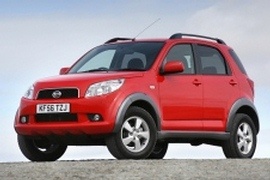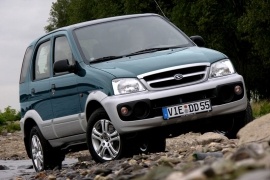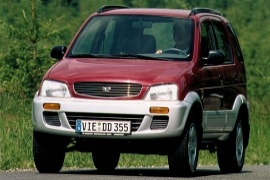DAIHATSU Terios Models/Series Timeline, Specifications & Photos
First production year: 1997
Engines: Gasoline
Body style: SUV (Sports Utility Vehicle)
Daihatsu introduced the second generation of the Terios in 2006, and, just like its predecessor, it came with an unusual design for an off-roader.
The Japanese automaker was under Toyota's umbrella, and they noticed a rise in demand for crossovers and SUVs. While other manufacturers had to develop one from scratch, Daihatsu didn't have to since it already had a proper platform and the technological expertise to build one.
But if the technical department was ready to create a new small-sized SUV, the design department wasn't on the same page. Thus, the Terios looked very rounded on all sides. At the front, the swept-back headlights didn't look like they belonged to an off-road vehicle. Yet, the flared wheel fenders gave the impression of a true 4x4 vehicle. The door panels on the sides looked very tall compared to the car's height. Moreover, the windows were not that big. Still, the designers had a good idea to install a small window behind the rear doors and blacken the D-pillars to create a wrap-around image at the back of the vehicle.
Inside, the Terios was actually roomy enough for four adults. Even though everything looked like it was penned for a small-sized city vehicle, they were installed in an SUV. The binocular-style instrument cluster hosted the speedometer in the middle, the tachometer on the left, and the fuel gauge on the right. Terios' high-mounted front seats allowed the automaker to create more room for the rear-seated passengers. Finally, the small trunk in the back was large enough to carry a couple of backpacks for children.
Under the hood, Daihatsu placed a 1.5-liter gasoline engine that was good enough to move this small vehicle in town. Moreover, it installed a 4x4 system, which was useful in the winter.
Daihatsu was keen to offer the Terios on the European market, but it had to improve it to comply with the Euro 3 emission standards that were introduced in 2000.
Just three years had passed since the introduction of the Terios in the European market, and the Japanese automaker had to refresh it. While other automakers used the facelift to improve the rest of their cars greatly, Daihatsu spent more money on the engine and less on the Terios' exterior. Yet, some changes have been made.
With the facelifted version, the Terios received a new, chromed grille at the front flanked by the same headlights as its predecessor. In addition, the front bumper was improved and had two round fog lights on its outer side and two round holes next to them on the inner side, flanking a lower grille. In addition, the bumper was continued on the sides by plastic panels that were extended toward the rear bumper. This lower protection was silver, regardless of the car's color.
The interior featured high-mounted seats, so four passengers could sit inside. At the front, the plastic dashboard sported an instrument cluster with a four-dials layout. In addition, the center stack was continued by a slimmer center console where the gear stick was hosted. The higher trim levels received power windows at the front, while the rear doors sported cranked ones.
But the most significant change was under the hood, where Daihatsu installed a DOHC engine with the same displacement as on the non-facelifted version. The new Euro 3 powerplant offered just a mere three hp more than its predecessor. All vehicles came with an all-wheel-drive system.
Daihatsu built the Terios as a new range for small off-road vehicles, and it suited better in the urban environment thanks to its small size.
Daihatsu was one of the oldest internal combustion engine manufacturers in Japan, and it was specialized in small off-road vehicles. Its presence on the European market was helped by its cooperation with Bertone design studio and BMW, who supplied the engines. On the other hand, Terios was a 100% Japanese vehicle built as a global contender for the small carmaker. It was available on most continents.
Its look was determined by the Kei-car Japanese category, which affected its size. A short hood at the front and very steep A-pillars started the form of the small crossover. While the Japanese version had to fit inside a 3.4m (133.7") length, the rest of the world received the full-size version with a 3.8m (152") long version. The car featured taillights mounted high on the D-pillars. Due to the short vehicle length, the carmaker had to install the spare wheel on the tailgate. That was a detail that enhanced the off-road look of the car.
Inside, it could barely fit four adults in a very tight cabin. The vehicle was so narrow that an average height adult could easily reach the doors from the right side, from the car's left side. Its dashboard followed the Japanese minimalist design style. Its ventilation controls were placed on the center stack, over the radio-cassette player. In the instrument cluster, Daihatsu made room for two large dials and two gauges.
Under the hood, Daihatsu installed a small range of engines, depending on the market. The most common version was the 1.3-liter gasoline unit paired with a 5-speed manual. A 4-speed automatic was on the options list.


